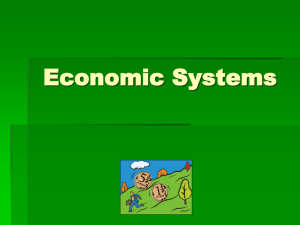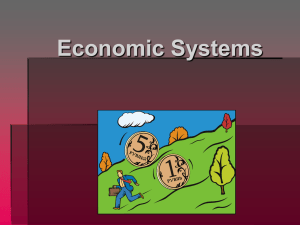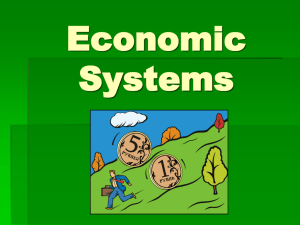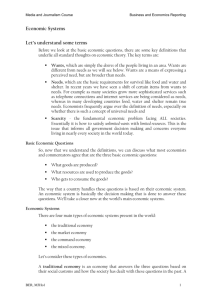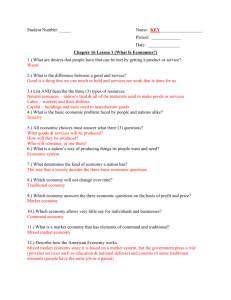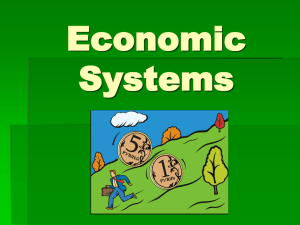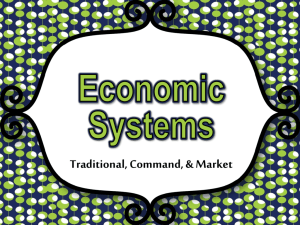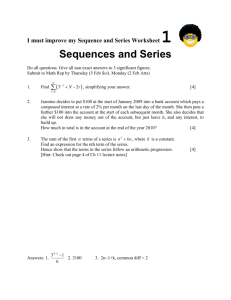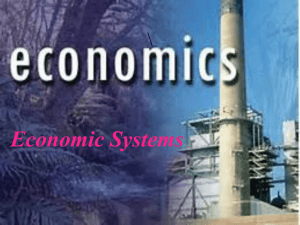Economic Systems Notes - Swartz Creek Community Schools
advertisement
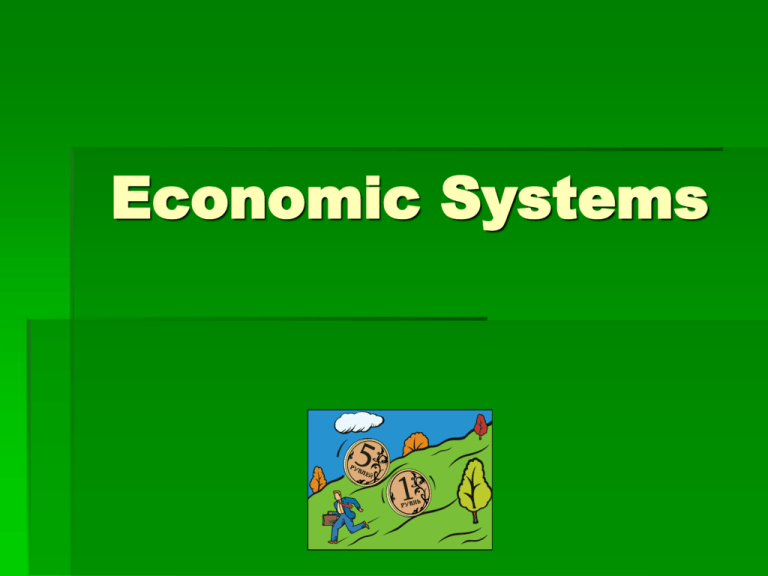
Economic Systems The Big Ideas! Economic systems are different ways that people use resources to make and exchange goods and services. Literacy rate, life expectancy, and Gross Domestic Product measure economic development. Some countries have a wide mix of economic activities, while others may have only one or two main economic activities. Countries of the world are grouped based on their level of economic development. Divided into 2 categories Developing nations Developed nations. Economic Systems An economic system describes how a country’s economy is organized Because of the problem of scarcity, every country needs a system to determine how to use its productive resources An economic system must answer 3 basic questions…but first, a vocabulary break. Vocabulary Break Economic System: The system of production, distribution, and consumption of goods and services Scarcity: The limited supply or availability of a resource 3 Questions for Economic Systems WHAT TO PRODUCE? (What kinds of goods and services should be produced?) HOW TO PRODUCE? (What productive resources are used to produce goods and services?) FOR WHOM TO PRODUCE? (Who gets to have the goods and services?) The way a society answers these questions determines its economic system. The 3 Basic Questions Four Types of Economic Systems: 1. Traditional Economy 2. Command Economy 3. Market Economy 4. Mixed Economy (Market + Command) Traditional Economy The oldest economic system in the world; not used much today A system in which people grow their own food and make their own goods An economic system in which economic decisions are based on customs and beliefs People will make what they always made & will do the same work their parents did Exchange of goods is done through Bartering: trading without using money Found in rural and remote communities Traditional Economy Who decides what to produce? People follow their customs and make what their ancestors made Who decides how to produce goods & services? People grow & make things the same way that their ancestors did Who are the goods & services produced for? People in the village who need them Traditional Economy Examples: Villages in Africa and South America; the Inuit tribes in Canada; Used recently in Argentina during difficult economic times Command System The government owns most of the resources and businesses that produce goods and services & owns most of the property The government decides what to produce, how much to produce, and what the prices will be Governments also determines the wages of workers Also called a planned economy This system has not been very successful & more and more countries are abandoning it Command Economy Who decides what to produce? Government makes all economic decisions Who decides how to produce goods and services? Government decides how to make goods/services Who are the goods and services produced for? Whoever the government decides to give them to Command System Countries with communist governments have Command economies Found in North Korea and Cuba; the communist governments of these nations own and control most businesses *Germany and Russia have moved away from having a Command economy since 1991. Now they have a Mixed economy. Market Economy An economic system in which economic decisions are guided by the changes in prices that occur as individual buyers and sellers interact in the market place A system based on private ownership, free trade, and competition Most of the resources are owned by private citizens Sometimes called capitalism or a demand economy Economic decisions are based on Free Enterprise (competition between companies) Important economic questions are not answered by government but by individuals Government does not tell a business what goods to produce or what price to charge Individuals and businesses are free to buy and sell what they wish Prices are determined by the supply and demand for goods The most common economic system used in the world today Market Economy Who decides what to produce? Businesses base decisions on supply and demand and free enterprise (PRICE) Who decides how to produce goods and services? Businesses decide how to produce goods Who are the goods and services produced for? consumers Market Economy There are no truly pure Market economies, but the United States is close. Mixed Economy Market + Command = Mixed There are no pure command or market economies. To some degree, all modern economies exhibit characteristics of both systems and are often referred to as mixed economies. Most economies are closer to one type of economic system than another Businesses own most resources and determine what and how to produce, but the Government regulates certain industries Mixed Economy Who decides what to produce? businesses Who decides how to produce goods and services? Businesses, but the government regulates certain industries Who are the goods and services produced for? consumers Mixed Economy Most democratic countries fall in this category (there are no truly pure Market or Command economies). A combination of command and market economies which provides goods and services The government may own some industries, while others belong to private owners Examples: Brazil, Mexico, Canada, UK, etc. Which Economic System Is Best? Let’s do some research and find out!
